One of the fundamental assumptions we make about video games as a medium is that every game series must have an individual style. We take it for granted that we could pluck any one IP out of the air and see consistent aesthetic themes, gameplay themes, or both running between its instalments. For example, if we pick the Gears of War series, we can see all its games have a distinctive style of gritty gunpunk sci-fi woven around arenas of cover-based shooting. If we pick Assassin's Creed, we can see a collection of alternate history games featuring free-running and light stealth combat. Even if we pick a series like The Legend of Zelda, one that has undergone radical shifts in settings, camera perspectives, and even art styles over the years, we can still identify a very precise set of mechanics, controls, structures, and items which run through the whole franchise.
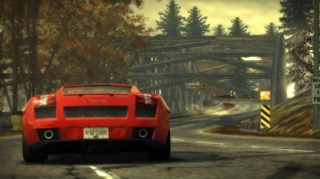
Game series' are built with predictable patterns of design for not just creative reasons but also business ones. There's a lot of monetary value placed on building a brand and making sure players know what they're getting every time they buy a product. This is especially true for annual franchises because they cater to an audience who aren't looking for subversive, chameleon experiences, they're looking for reliable and rehearsed sights, sounds, and feels that they can fall back on for a little enjoyment without having to do a lot of research beforehand. That makes Need for Speed a very bold series. You could be forgiven for forgetting that NFS is brought out on a yearly schedule, the term "annualised franchise" is more commonly used to refer to modern military games and various sports series, but there has been at least one new Need for Speed game released every year since 2002. The reason Need for Speed doesn't stand out as an annualised series is because it doesn't follow the iterative blueprint we associate with annual franchises.
Despite hitting shelves on a yearly schedule, Need For Speed games released a few years apart, or even only a year apart, can have wholly different stylistic underpinnings. You can easily demonstrate this by asking simple questions about the games. For example, what's Need for Speed's art style? Well, 2006's Need for Speed: Carbon is all about blue-tinted night-time racing, but 2007's Need for Speed: ProStreet is coated in grey asphalt and graffiti. 2008's Need for Speed: Undercover uses a city in perpetual daylight with cutscenes thick with yellows and oranges, and 2009's Need for Speed: Shift is in a far more utilitarian style. What's the game structure and the role of police? 2005's NFS: Most Wanted is an open-world game teeming with police, but 2006's NFS: Carbon makes far less use of police and has you selecting races from a map to take over territories. 2007's NFS: ProStreet confines races to tracks, has no police, and has far more linear progression, while 2009's NFS: Shift is a straightfaced simulation racer.
There are plenty more disparities to find, but you get the idea: Need for Speed breaks the cardinal rule for annualised franchises by never wearing the same dress twice. It's able to pull this off as a business practice because it isn't relying on an audience as broad as most other games launching on a yearly basis. NFS is aimed at a group of people who EA believe are just comfortable and versed enough in virtual racing to want to see something new in the genre every year. It probably helps that there aren't as many arcade racers vying for attention as there are sports games or first-person shooters. Need for Speed's constant identity switches cause the series to lack a singular personality and they give it many peaks and valleys in terms of quality. The latter issue is down to NFS's developers not getting practise at refining one general formula for the game. Instead, they're taking a crack at a new idea every time and hoping it pans out, or if they're not doing that, they're trying to resurrect older concepts that haven't been touched in a while and were probably put together by another studio. However, there are also pros to this approach.
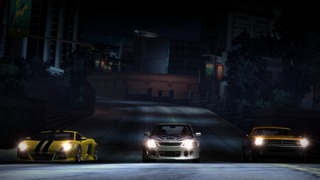
Changing the style of your game every year creates variety, as does switching development studios so often. It also makes it easy for studios who've never laid hands on a Need for Speed before to develop a new, functional game in the series within a limited time frame. For a conventional game series new studios being brought into the fold would have to work hard to emulate the styles of previous developers, but when working on Need for Speed, devs have permission to take on the job using their personal concepts and means of implementation. After all, the audience can't hold them to a strict Need for Speed continuity. Studios can, at least in theory, take the parts of NFS that gel with their philosophies and throw away the rest, or if that doesn't work, they can forge a whole new branch of the franchise. In Criterion's Need for Speed: Hot Pursuit (2010) we see a studio very intent about which method they want to use, and they expend an incalculable amount of effort forgoing that "new branch" route and sticking tight to the conventions established by a couple of particular NFS titles.
The original Hot Pursuit games (Need for Speed III: Hot Pursuit in 1998 and Need for Speed: Hot Pursuit 2 in 2002) were defined strongly by three elements: police chases, shortcuts, and a wide variety of natural environments for races to take place in. On paper, Criterion would seem well-suited to picking up and running with these elements. Police chases were the subject of Burnout 2's Pursuit Mode and Burnout Paradise's Cops and Robbers DLC, and Burnout Paradise gave players frequent opportunities to utilise shortcuts during events. Paradise also featured a range of environments from beach to urban to rural, and Criterion's aggressive flavour of driving could map well to thrilling police vs. street racers conflicts.
The problem is the game lacks a meaningful identity as both a Criterion product and as a part of the Need for Speed series. With the arcade racers that Criterion had made up until 2010 they'd shown a rebellious and pioneering attitude towards the genre, but in Hot Pursuit, they deliberately pass over that key twist in the NFS series that lets studios take their own direction with it. Instead, the studio tries to be more encompassing and respectful of the established ideas of the Hot Pursuit subseries. While that shows some humble intentions and is an understandable choice coming from a developer that had been working on Burnout for the better part of a decade, it leaves them putting a lot of faith in conventional and dated designs that their own games had surpassed long ago. It also has them trading in their spirit of punk rock subversion for a sterile muteness.
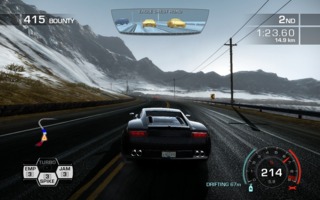
Hot Pursuit is a game with plain, understated UI elements and little flair in the way it depicts cars and environments. You can understand where it might have gotten its highly formal presentation style: It's very common in the racing game genre, embodied by titles like Forza and Gran Turismo, but remember that those games are trying to recreate driving as a real-world sport. Hot Pursuit is seeking to create action movie-style police pursuits, and yet it tries to do it with this complacent lack of enthusiasm in its presentation. There are some elements of the game's art that make you snap to and pay attention: It has that knack Paradise: Cops and Robbers had for finding many different shapes and paint jobs for its police cars, the game reintroduces that awesome Paradise crash cam, and once in a blue moon it throws you these dramatic, stormy night levels. However, most of the time it seems like Hot Pursuit is frightened of doing anything more than dipping its toes into the waters of personality.
One of the reasons this game is so impersonal is that often the only signs of other humans in the world are the purely practical chatter of the police radio and the robotic advertisers flogging various automotive products. Even the voices of the real Criterion employees turned eerily silent throughout the development of Hot Pursuit. While working on Burnout Paradise and its DLC, the dev house had kept up a podcast series which wasn't afraid to let the people in the trenches talk directly to their audience. These personal check-ins with Criterion staff stopped the moment they transitioned from working on Burnout to working on Need for Speed.
Like many other racing games, Hot Pursuit is also willing to give up its own voice to both emulate and legitimately act as marketing for motor companies. The first thing you see when you boot the game up is a screen of logos for various car manufacturers and the feature list includes a "Photo Mode" where you can voyeuristically swing your camera around branded vehicles and snap pictures of them. This might not seem so needlessly fetishising if the photographs you take weren't called "Dreamshots". Additionally, the cars in your garage are accompanied not by descriptions of themselves but by the marketing slogans that were used to sell them, and the game even has achievements for just sharing pictures of BMWs and Ford GTs with other players. Despite having little to do with urbanity, Hot Pursuit often assumes the hollow self-importance of a car showroom.
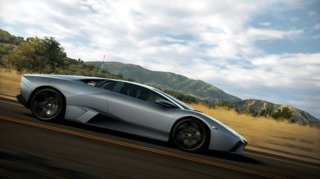
Criterion's unwillingness to represent themselves in the experience also creates problems in the gameplay. Burnout Paradise had a special contract with its audience: You had to accept that sometimes you'd be punished unfairly, crashing into obstacles that appeared out of nowhere or that you weren't given the time and clarity to process. However, if you could agree to that, you were rewarded with a feeling of raw, unrestrained speed and time in one of the best open-world playgrounds to date. It's almost impressive how Hot Pursuit manages to keep so many of Paradise's unfair punishments while offering so much less reward for enduring them.
There are two things that a video game needs to supply when challenging you in any way: 1. The clear means to read the details of the challenge and 2. The tools to reasonably overcome the challenge. Burnout Paradise had problems with the former but was pretty good with the latter. However, Hot Pursuit struggles with both. In Paradise, the low camera, high speed, and spontaneous pile-ups meant that hazards were hard to detect or anticipate, but the punchy, responsive movement of the cars allowed you to dart quickly out of the way of any potential crashes you saw coming.
In Hot Pursuit, your vehicle just can't change direction all that quickly, and it gets caught up in its own momentum. It paints these broad, curving lines across the track as you try to force yourself one way or another, meaning that even when you identify danger up ahead and try to slip out of the way, you often can't move fast enough to dodge a crash. In these situations, it feels like you're displaying reasonable hand-eye co-ordination in the face of trouble, but the game treats you as if you'd failed to detect the hazard entirely. You might think that this is balanced out by Hot Pursuit moving at a slower speed than Paradise, being set out in the wilderness where there's less traffic to collide with, and through it having boosts that only burn for a short time. These things all help, but the game is lousy with cheap hazards and poor signalling about the world state that make it so much less than it should be in this department.

Vehicles still hit each other with no warning to create obstacles it's difficult or impossible to avoid, AI sometimes create obstacles by coming to a complete stop in the middle of the road, other racers can collide with police roadblocks in ways that make them impossible to pass, dust clouds behind cars obscure hazards ahead, the headlight glare of oncoming cars obscures hazards ahead, cars themselves obscure hazards ahead, night-time conditions obscure hazards ahead, hills obscure hazards ahead, corners obscure hazards ahead, Helicopter spotlights obscure Spike Strips beneath them, and the game will spawn you right in front of hazards and other objects. Tracks in Hot Pursuit usually have to be run with very few slip-ups for you to succeed, but the game doesn't give you the precision tools you'd need to reliably avoid mistakes. You find yourself taking fewer of those exciting, death-defying risks than you did in Paradise because coming back from a crash is such an arduous process and most of the time winning in Hot Pursuit means not just displaying skill but also being lucky enough not to fall into the game's cruel traps.
Driving a car that can't quickly bob or weave also makes it so that, unlike in Paradise, you can't make the sharp, spontaneous swipes to hit cars parallel to you. A fundamental mechanic in any game combat is having a quick and basic means of attack to wield against your opponents. Think about the standard punch in Punch-Out or being able to fire a pistol at someone in an FPS. Attacks like these provide an immediate way to feel like you can affect the circumstances of the competition, but there's no attack which fills this role in Hot Pursuit. You don't feel the kind of immediate agency that you need in a combat-based experience like this one and even when you can get a good hit in on another vehicle, it's frequently after engaging in some finicky positioning. Along similar lines, it's not unusual to try and strike a car and end up drifting past it or be forced to slow down and wait for a vehicle to overtake you before you can hit it. These scenarios actively undermine the high-speed racing dynamic the game is going for. Sometimes you even give up your chance to hit a vehicle because from behind opponent cars look confusingly similar to civilian ones.
These shortfalls put the game's sterile presentation in a different light. Typically, games use formal presentation over stylised presentation as a trade-off that lets them be as clear as possible about what's happening in the play, but it's frequently unclear what's going on in Hot Pursuit. The product has shiny, impersonal HUDs, menus, and models, but they're accompanied by gameplay and visual effects which confuse the player about the game state, meaning the visuals don't empower the technical aspects in the way they should. The shortcut mechanic follows suit.
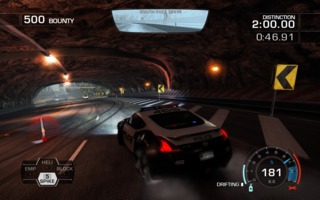
Shortcuts through courses are a way Criterion can provide more freedom in the routes you take and honour your observation and navigation skills. Using shortcuts is essential for keeping up with other drivers, dodging cops, and sometimes pursuing targets, but consistently trying to use shortcuts feels like threading a needle. The minimap is drawn in such a way that it doesn't act as an accurate guide for when you're coming up on one of these shorter roads, and the game is often too fast and visually busy for you to spot them just by looking at the track. Keep in mind that wide sway on the vehicles which means you need to start turning off for a shortcut sooner than you would have in Burnout Paradise and can't just slip into it at the last second.
Staring at a minimap is a dispiriting way to spend time in any game, but the way Hot Pursuit sets it up, you almost always need to have your eyes on the road to not wipe out, yet almost always need to have your eyes on the minimap so you don't miss shortcuts and fall behind. You can't win. The minimap also rarely depicts the multiple paths spread through these routes, leaving it up to you to blindly fumble your way to the quickest one. There are even roads that appear to be shortcuts at first that then turn out to be longer than the regular track.
The shortcuts can be understood as a carryover from Burnout Paradise where they were a fun feature of the map, but Paradise had these long periods of open-world roaming where you were incentivised to search for collectables. You discovered ways to cut corners between roads as a side-effect of performing that legitimately satisfying activity and when you learned shortcuts, you learned them on your own terms, at your own pace. Even when you didn't have them memorised, Paradise rarely made a big deal about it: In Races and Marked Man events, they were a useful trick if you could pull them off, but winning wasn't contingent on hitting the vast majority of them. Hot Pursuit is the exact opposite of that and you can't even view its shortcuts as "optional routes" that open up the map when their use is so mandatory.
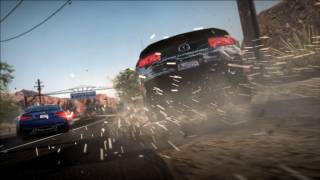
Missing a shortcut is also one of the myriad ways an event can fall apart right in the final moments. Events are so lengthy, and failure can come so randomly, that you can easily waste minutes on any single event just to get one-upped at the last minute. The Races, in particular, feel needlessly time-consuming. If you can suddenly be shut out of a winning position in the last few miles of a Race and your success early in a Race doesn't give you any more advantage later on, then why are their tracks several miles long? The first two-thirds of the event end up feeling like filler and then the last third comes to be the bit that matters.
These problems build with another issue: Unlike Burnout Paradise, Hot Pursuit makes it so that opposing vehicles can't be taken down with one good ram, they have a pool of health that has to be whittled away over multiple hits. It's probably an attempt to make car combat beefier, but it also means that you can't have those glorious chains of takedowns that pushed Burnout Paradise from just being cool into being thrilling. It was a way in which Paradise parcelled out solid, short-term rewards, but Hot Pursuit has little scheme for doing this, and even long-term rewards can be far between when fluking into losses can become a familiar experience.
Longer battles in games usually also demand more depth or variation than short ones. Think about how boss fights typically have unique mechanics or how enemies that go down in one hit usually have fewer attacks than those who require multiple hits. This is because designers forcing you to repeat the same attack patterns and dodges many times in a row gets boring. By asking you to slam into the same cars over and over to take them off the road, Hot Pursuit can engineer that kind of boredom. However, that's not to say that the game doesn't evolve Criterion's brand of vehicular combat in some way.
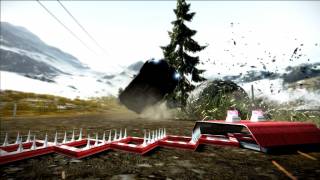
Hot Pursuit has you not just making physical contact with other cars, but also utilising specific weapons like Spike Strips and EMPs to do so. While Burnout was only about melee car combat, the equipment in this game extends your attacks into the ranged and environmental realms. Dropping a Spike Strip at just the right point to disable another racer is gratifying in a different way than just smashing into them and these gadgets represent more elaborate ways to disable other drivers. Another way to look at this is that Hot Pursuit provides a more straight-laced interpretation of cart racer mechanics, which is a surprisingly exciting feature. These weapons are however held back by the reluctance of the game to just let you loose with them.
Equipment doesn't appear in at least half of the event types in the game and in the event types it does appear in, it's very slowly introduced. You crawl from using one type of equipment near the start of the game to some events having four types nearer the end. By comparison, Mario Kart Wii (released two years earlier) gives players sixteen items to use right from when they start playing. What equipment there is isn't plugged into the UI that well. It's all mapped to the D-Pad, requiring a left thumb press to be used, but you need that thumb on the left stick for steering. You get stuck between a rock and a hard place as launching a weapon requires taking a hand off the metaphorical wheel, which is the last thing you want to do when you have to maintain a constant lookout for obstacles and shortcuts.
The game also fails to instil a sense of challenge when having you execute attacks with the equipment. In most games, successful attacks are contingent on a balanced transaction between you and the game. As a player, you have to display a certain level of skill, and if you manage to do so, you're rewarded with damage being done to your opponent proportional to that display of skill. If we want to use some simple shooter examples, we can see that lining a sniper rifle up with a person's head and pulling the trigger shows a lot of skill and so it comes with a lot of reward. Successfully shooting a person with something like an assault rifle requires less skill, and so you're given less reward for it, but even attacks like this one should require something approaching skilled input on the part of the player. If they don't, the awarded advantage feels empty, and any players hit by the attack are likely to feel that they're being unfairly punished. For about half of the equipment in Hot Pursuit, this breed of emptiness and unfairness is abundant.
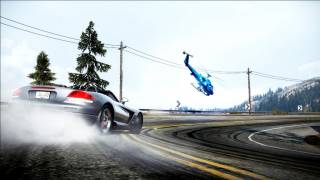
The EMP is a timer-based weapon that can hack some health off your target provided you can keep it locked onto them, but the stiff steering of the vehicles extends into stiff aiming of this weapon. Not to mention, your aim can be thrown off by those unpredictable hazards, and if you're the one on the receiving end, then it's often hard to dodge the EMP. Unlike in the shooter games that inspired this weapon, you don't have free movement around the map. Every car is stuck on the same track moving in a single line and can't make a sharp turn unless that's the way the road ahead goes, so dodging a weapon like this is a bit of a moot concept.
The Helicopter is another tool that requires too little from the player. Deploying it just involves hitting a button to summon an AI and then watching that AI carry out the actual attacks, but it's the jammer that is the ultimate in lazy execution. All anyone has to do to hit players with the Jammer is press the button for it in the very general area of those players and sit back as their targets' minimaps and equipment are disabled. It feels somewhat impotent against AI because you know they're not looking at a minimap, and it's never fun to be targeted by it and have your weapons and HUD sabotaged. It's a favourite tool of the computer players and it's sad that the game so often resorts to reducing your strategic options and breaking the GUI as a form of challenge.
Taken as a whole, the equipment represents one of the troublesome themes of the game's design: Where Criterion's previous work created a genuinely new experience by transforming video game racing from the base upwards, the unique mechanics and concepts of Hot Pursuit are frequently just peripheral to that base, only serving to lightly augment a generic and often frustrating driving experience. It's a theme as present in the multiplayer as it is in the underlying driving dynamics, but before we can talk about that, it's important to understand that we can't cleanly divide Hot Pursuit into one mode where the single-player components exist and one mode where the multiplayer components exist. Instead, the game reflects a period of transition in the medium when the lines between the single-player and multiplayer in many genres were starting to blur.
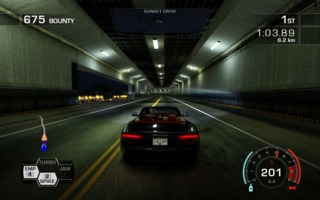
Hot Pursuit gives you a shared progression level which carries between single-player and multiplayer modes, it recommends single-player events based on the performance of friends, and rewards you for beating your friends' single-player records. These features introduce a welcome new dimension of competition and success to what would otherwise be a purely solo affair, although Hot Pursuit also includes a Facebook wall analogue that doesn't give you as much to be invested in. The wall is a constant feed of text posts and photos from friends in the game, but this content delivery network feels like another satellite to the game's more substantial experiences. Hot Pursuit over-estimates how much anyone wants a social network that is dedicated solely to posts about a single instalment of an annual racing series.
The act of melding single-player and multiplayer became better refined with later arcade racers like Forza Horizon and Need For Speed: Most Wanted which served up more frequent, detailed, and seamless comparisons of your performance to your friends'. Take for example Horizon immediately showing you your time on speed-traps relative to other players' or Most Wanted letting individuals "own" billboards based on leaderboards tied to them. When you take it apart, Hot Pursuit couldn't have supported this kind of eagle-eyed stat-tracking anyway as there's not that much in the experience to track. The game doesn't have that kind of depth, and neither does its dedicated multiplayer mode where the single innovation is more about the mode as a product than it is about the mode as a means of entertainment.
A common problem with annualised games like Hot Pursuit was that their multiplayer modes would get abandoned for more current experiences, and they typically had such modes gated by online passes. If you picked the game up second-hand a year or two after release, you could easily put yourself a few pounds out of pocket paying for a pass to a non-existent online community. Hot Pursuit is smarter than that, providing a fix in the form of a two-day free trial of the multiplayer mode. It's enough time to get in, check whether there are still people playing (there aren't), and get out. I'd bet that's not the purpose the devs had in mind for the free trial, but it works none the less and was considered good enough for EA to implement the same idea for a wider audience in Battlefield 3.
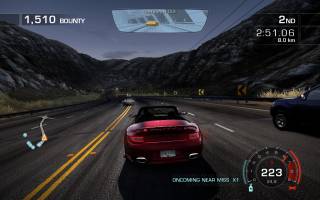
Unfortunately, even if there was still an active community for Hot Pursuit's multiplayer, the mode is highly predictable in its feature list. There are two ways to do a multiplayer mode: Either you make it a version of the single-player that multiple people can participate in, or you launch off of the unique opportunity of having many players in one space to create a section of the game with a set of rules distinct from those of the single-player. You'll notice that Burnout Paradise used a combination of both methods, but was at its best when it was employing the latter, providing a mountain of online challenges that put the game's potential as a platform for co-operative fun to work. Hot Pursuit, on the other hand, prefers the former option.
This "singleplayer but with more people" approach to multiplayer might not be an inferior direction by default, but a game implementing that concept needs robust core mechanics to make it work. When a game engages this kind of design, it presents its fundamental gameplay, only without the progression and sometimes the story of the single-player to prop it up. It's a format in which the core gameplay has to be able to stand well on its own, playable as a kind of light e-sport, but Hot Pursuit's core feel and rules aren't up to that standard. The multiplayer mode fails to stand away from the single-player as a distinct experience with a self-contained identity, and this can be seen as a byproduct of Hot Pursuit being squeamish about displaying personality overall. The relationship between the single-player and multiplayer is also the relationship we see between the game's two major factions.
Hot Pursuit has you playing as both criminals and police, with each side getting two unique pieces of equipment and two pieces of equipment which are shared between both sides. Unfortunately, the unique equipment is introduced further into the game, and you tend to be given fewer uses of it than you get uses of the shared equipment. The cutscenes that announce the arrival of new equipment for each side are also both rendered and voiced in this very similar tech breakdown style, and you feel identity confusion working your way up through the ranks of the police and the criminals at the same time, acting and being addressed as being on a different side from one event to the next. When swapping between law enforcement and law breakers, it rarely feels like you're switching between two sides of this stark order/chaos divide, it just feels like you're changing hats.
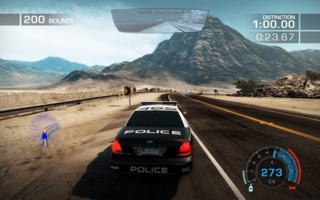
The game does try to give the cops and the racers event types tailored to them as factions, and that helps, but only up to a point, and many events are simply irritating. The racers' bread and butter are the unadorned Races which are as offensive as they are because they present the driving mechanics in their purest form with nothing to distract from all their blemishes. The cops' gameplay has a more varied quality, being the stage for both the best and worst events in the game. That best event has you laying waste to multiple opponent cars in a short space of time, not unlike Burnout's Road Rage mode. It's brutal, paint-scratching, tire-popping fun. The grim price you pay for that is having to play no small number of time trial events where you must run a course as fast as possible but are given a time penalty every time you collide with a wall or another car. It's horrible from both roleplaying and mechanical standpoints. Nobody, in the history of the moving picture, has watched a high-speed police chase and thought that the fun part of being an officer must be following all the rules and receiving procedural punishments when you screw up. Even if you manage to accept the event's shaky premise, it's almost impossible to drive in the lightning fast but diligently delicate fashion it asks for. The whole thing resembles being given a bumper car and then told to run the Indy 500.
When you filter out which events leave you eager for more and which just test your patience, it reveals an important truth about the game that I wish the developers had been far more aware of: Hot Pursuit is better when it's trying to be a vehicular combat game than when it's trying to be a generic track racer. Again, Criterion is at their best when crafting anarchic and aggressive driving games, and Hot Pursuit comes undone by them putting too many of their eggs in the traditional, by-the-manual driving game basket. Side-by-side Burnout Paradise and Need For Speed: Hot Pursuit depict a creator going from their absolute best work to some of their absolute worst through trying to wear a face that is not their own.
With this in mind, you might conclude that Criterion's mistake was not making a more Criterion-like game within the Need for Speed framework, but that theory is sharply shot down by the next title Criterion put out: 2012's Need for Speed: Most Wanted. Most Wanted is almost exactly Burnout Paradise but with a few tentpoles from EA's racing franchise jammed in there for good measure. Most Wanted's use of environment mirrors Paradise's in that the game lays out an open-world split between rural and urban regions with the biggest stunt areas built around unique landmarks. The game then makes this map the grounding for both the single-player and multiplayer. Most Wanted's mechanics mirror Paradise's in that it has collectables that include jumps, billboards, and gate smashes, it has enemy cars that you can comfortably sideswipe for takedowns, and its multiplayer is a mix of co-operative and competitive challenges. Despite all this, Most Wanted still feels off; it's an uncanny, puppet-like version of Criterion's 2008 white knuckle racer.
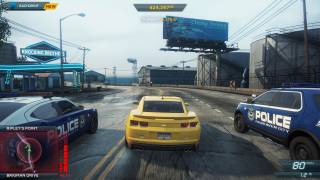
The driving is still too taut, the game's police are petty and annoying rather than menacing, cars don't have boost by default, and like Hot Pursuit the game lacks personality because it has a scarcity of characters and inspired visions for its setting. Again, almost everything that makes you want to play Most Wanted is carried over from a previous Criterion game, and everything that dissuades you from playing it is some vestige of Need for Speed as a series. When you construct this trifecta of Paradise, Hot Pursuit, and Most Wanted, they tell a sad story. They suggest that the problem with Hot Pursuit was not Criterion "doing Need for Speed wrong", but that the poison in the mixture was Need for Speed.
I'm not saying that NFS is a bad series or that somebody shouldn't be making those games, but with all the cards on the table, it's hard to believe Criterion was the right choice as the developer. At least, if they were, they should have had minimal reverence for Need for Speed as a franchise and continued doing what they were doing excellently already. This studio created perhaps my favourite racing game ever, then immediately got lost in this thicket of resurrecting older games for big, corporate overlords. Today, eight years on from Burnout Paradise, this process has left Criterion unrecognisable as the studio who created that defiant and absurdly fun experience in the late 00s and that's just tragic. Thanks for reading.
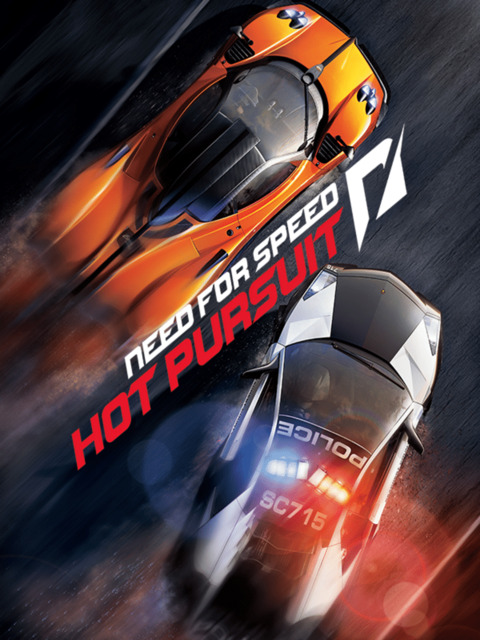
Log in to comment